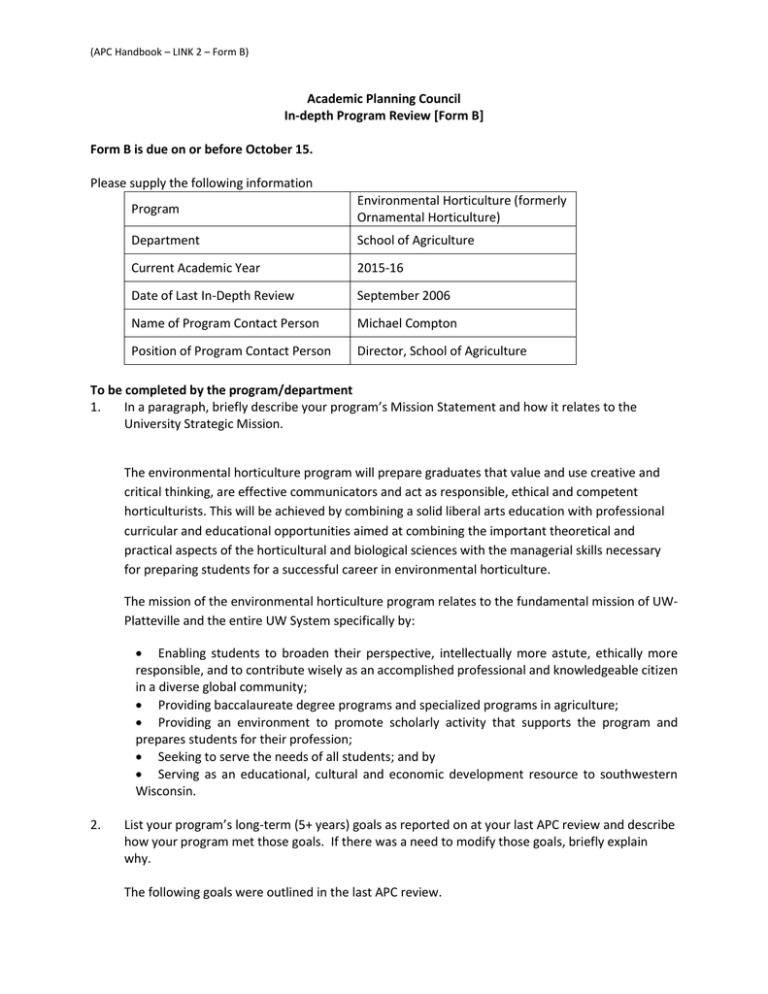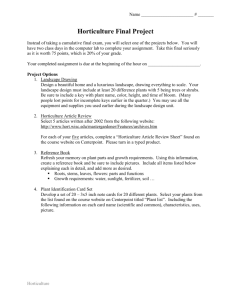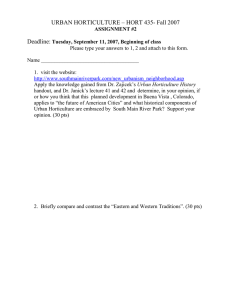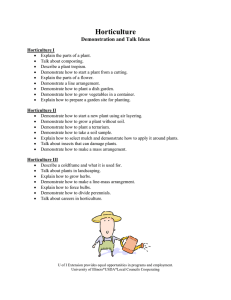Please supply the following information Environmental Horticulture (formerly Program
advertisement

(APC Handbook – LINK 2 – Form B) Academic Planning Council In-depth Program Review [Form B] Form B is due on or before October 15. Please supply the following information Program Environmental Horticulture (formerly Ornamental Horticulture) Department School of Agriculture Current Academic Year 2015-16 Date of Last In-Depth Review September 2006 Name of Program Contact Person Michael Compton Position of Program Contact Person Director, School of Agriculture To be completed by the program/department 1. In a paragraph, briefly describe your program’s Mission Statement and how it relates to the University Strategic Mission. The environmental horticulture program will prepare graduates that value and use creative and critical thinking, are effective communicators and act as responsible, ethical and competent horticulturists. This will be achieved by combining a solid liberal arts education with professional curricular and educational opportunities aimed at combining the important theoretical and practical aspects of the horticultural and biological sciences with the managerial skills necessary for preparing students for a successful career in environmental horticulture. The mission of the environmental horticulture program relates to the fundamental mission of UWPlatteville and the entire UW System specifically by: Enabling students to broaden their perspective, intellectually more astute, ethically more responsible, and to contribute wisely as an accomplished professional and knowledgeable citizen in a diverse global community; Providing baccalaureate degree programs and specialized programs in agriculture; Providing an environment to promote scholarly activity that supports the program and prepares students for their profession; Seeking to serve the needs of all students; and by Serving as an educational, cultural and economic development resource to southwestern Wisconsin. 2. List your program’s long-term (5+ years) goals as reported on at your last APC review and describe how your program met those goals. If there was a need to modify those goals, briefly explain why. The following goals were outlined in the last APC review. (APC Handbook – LINK 2 – Form B) Create separate Woody Plant and Herbaceous Plant Courses These courses were approved during spring 2007 and offered for the first time during fall 2007. Both courses are offered annually during the fall semester. Development of Landscape Construction and Advance Landscape Design Courses. These courses were approved during 2010 and offered beginning fall 2011. Landscape Construction is offered annually during the fall semester whereas Advanced Landscape Designed is offered in the spring semester of even years. Development of Plant Propagation and Nursery Management Courses and Emphasis. We decided postpone the development of these courses due to Dr. Compton’s appointment as director of the School of Agriculture and insufficient student enrollment. Update facilities at Pioneer Greenhouse and Pioneer Gardens Complex. o Addition of hydroponics equipment at Pioneer Greenhouse A $19,000 UW-Platteville laboratory modernization grant was received during 2008 to install a walk-in cooler, and construct Vertigro® and string hydroponic systems to grow herbs and tomatoes. Hydroponic production is discussed in introductory and advanced courses. Fresh herbs are marketed to UW-Platteville catering to generate revenue to offset the costs of purchasing supplies for Pioneer Greenhouse. o 3. Continued development at Pioneer Gardens Pioneer Gardens serves as an outdoor laboratory for experiential student learning activities in several classes including herbaceous plants, woody landscape plants, landscape management and landscape construction. Because of its youth, much work was needed in this area for installing plants, hardscape materials and raising funds. Working with UW-Platteville Foundation we have raised over $415,000 in cash and in-kind plant contributions to develop themed garden areas including the Children’s Garden, Rose Garden, Woodland and Shade Garden and construction of a Pond-less Water feature. At this point in your long-range planning, list your program’s most important (5+ years) goals and briefly describe the resources your program will need to be successful, as well as any concerns or issues your program is facing. Also briefly address how these goals support your program’s Mission Statement. (maximum of three) Long-term Goal One Increase enrollment to 50 undergraduates by 2020 Resources Needed Expertise to develop a marketing and outreach plan to recruit students. Issues or Concerns Identifying experts to help develop plan. (APC Handbook – LINK 2 – Form B) 4. How Goal Supports Program’s Mission Statement Accomplish our goal to increase our ability to prepare more knowledgeable and highly-skilled graduates to the horticulture workforce. Long-term Goal Two Update student learning outcomes and assessment tools Resources Needed Time and expertise Issues or Concerns Identifying experts to provide training and assistance in developing effective tools for assessment How Goal Supports Program’s Mission Statement Improves our ability to provide an outstanding education. Long-term Goal Three Seek accreditation with the National Association of Landscape Professionals Resources Needed Cost is $2500 Issues or Concerns Cost and Time How Goal Supports Program’s Mission Statement Being accredited gives national recognition to our program, helps with recruitment, allows students the opportunity to seek certification within the industry, and gives the program access to the latest technology through various publications improving our ability to offer an outstanding education and better prepare students for careers in the landscape industry. If your program was reviewed by any outside accrediting bodies since the last APC review, please identify the review body and briefly summarize the results in 1-2 paragraphs. Information Required by the Assessment Oversight Committee 5. Please provide the following information. A. Program Assessment Plan i. List your program’s learning outcomes. Goals and Learning Outcomes Graduates of the Environmental Horticulture program will: 1. Demonstrate effective oral and written communication skills. Outcomes: Students will enhance and value their written and oral communication skills with liberal arts and science-based knowledge Students will improve their self-confidence and comfort level during public speaking Students will be able to communicate with their peers in the environmental horticulture and botanic fields using professional terminology (APC Handbook – LINK 2 – Form B) 2. Exhibit working knowledge of ornamental plant species in Midwest landscapes, greenhouses, athletic fields, and public and interior spaces. Outcomes: Students will possess working knowledge of current plant nomenclature for important ornamental plant species Students will possess working knowledge of the care, use and placement of ornamental plant species in a variety of settings 3. Demonstrate an in-depth comprehension of the horticultural and biological sciences, and be able to apply their knowledge as it relates to environmental horticulture in a variety of settings. Outcomes: Comprehend and apply knowledge of plant physiological processes on plant growth and development of natural and bioengineered plants in production and landscape settings Comprehend and apply knowledge of genotypic and environmental influences on plant growth and development Comprehend and apply knowledge of the influence of soils and soilless growing media on plant growth and development in protected and unprotected environmental horticulture Comprehend and apply the basic principles of integrated pest management to control weeds, pests, diseases and physiological disorders of ornamental plants Comprehend and apply the basic principles of landscape design and management 4. Possess the ability to think creatively and recognize, analyze, diagnose and critically evaluate problems and practices, as well as employ problem solving techniques individually or using a team oriented approach. Outcomes: Demonstrate an ability to observe, investigate and evaluate problem situations to achieve clear and concise deductions Possess the ability to apply a logical, stepwise approach to solving practical problems Demonstrate an ability to collect and analyze information and compose professional, technical reports 5. Possess a comprehension of the administrative and managerial skills necessary when managing and operating a horticultural business. Outcomes: Competent in the application of computerized technology Comprehend effective management of employees and colleagues of diverse backgrounds Comprehend effective management and attainment of non-human resources Recognize and compare efficient and optimal production practices for sustainability 6. Be professionals and leaders in society and environmental horticulture that act in a courteous, ethical and responsible manner. Outcomes: Seek and participate in campus, community, professional and international opportunities Comprehend the need to act ethically and responsibly in professional and personal matters Appreciate the contribution of colleagues regardless of rank, race, gender or sexual orientation (APC Handbook – LINK 2 – Form B) a. Indicate when the last time each learning outcome was assessed. Each outcome has been assessed annually. ii. Program assessment tools. 1. Internship employer evaluation survey. a. Successful results occur when over 80 percent of employers respond that a student demonstrates at least an average competence for an individual outcome when compared to a typical first year employee. b. This tool is administered every semester when students are registered for an internship. c. Results: In general, a majority (over 95 percent) of employers have indicated that the Environmental Horticulture curriculum has effectively prepared our students to demonstrate competencies equivalent to a typical first year employee in all six of our student learning outcome areas. Furthermore, over 90 percent of employers rate our students as above average or excellent in being courteous and responsible professionals (SLO #6). About 80 percent of employers rate our students as above average or excellent in demonstrating an in-depth comprehension of the horticultural and biological sciences and the ability to apply their knowledge as it relates to environmental horticulture in a variety of settings (SLO #3), and over 75 percent of employers rate our students as above average or excellent in their managerial skills, their ability to think creatively, and solve problems (SLO #4), and their ability to exhibit a working knowledge of ornamental plant species in Midwest landscapes, greenhouses, athletic fields and public or interior spaces (SLO #2). d. Conclusions: While over 90 percent of employers indicated that our students demonstrated at least average oral and written communication skills, only 68 percent rated student writing skills as above average or excellent. This is one area in which improvements can be realized. In addition, only 58 percent of employers rate our students as demonstrating above average or excellent ability to recognize or identify plant insect, disease and physiological problems. While these are potential concerns, it is also important to realize that these topics are addressed in depth in upper level courses that many student interns have not completed before their internship experience. 2. Senior exit survey. a. Successful results occur when over 80 percent of students respond that they can demonstrate an “effective competence” for an individual outcome. b. This tool is administered every semester. c. Results: In general, a majority of students (88 – 100 percent) believe that the Environmental Horticulture curriculum has effectively prepared them to demonstrate competency in all six of our student learning outcomes. Some items of slight concern include student comfort level in public speaking, and their ability to apply the basic principles of integrated pest management to control weeds, pests, diseases and (APC Handbook – LINK 2 – Form B) physiological disorders of ornamental plants (75 percent of the students believed that the curriculum does not effectively prepare them in these areas). d. Conclusions: While student feedback indicate that they are confident in their ability to demonstrate satisfactory competence in the six student learning outcome areas, we will rely more heavily on input from employers as we continue to hone our tools to measure the outlined student learning outcomes. 3. Job placement data. a. Successful results occur when over 80 percent of students obtain gainful employment within one year of graduation. b. This tool is administered every semester. c. Results: Over 90 percent of the students that complete the career placement survey indicate that they obtain gainful employment. One problem is that only about 60 percent of graduates complete the survey despite our repeated requests for information. d. Conclusions: Student response rate is lower than desired. Work with career center to improve the survey response rate. 4. Employer evaluation of recent graduates. a. This tool has not been administered. It is extremely difficult to maintain this data and administer the tool. We have decided to eliminate this tool. 5. Class learning evaluations. a. This tool has not been administered. It is our goal to develop a new tool(s) that can be efficiently administered by our low number of faculty. iii. What changes to the program (if any) were made in response to the program assessment results and how have you assessed the effectiveness of those changes? The student learning outcomes for environmental horticulture were completely changed two years ago following my participation in the North Central Horticulture Administrators conference held at Cornell University. During that meeting we constructed a set of student learning outcomes to be used for horticulture programs nationally. We were one of the first baccalaureate universities to adopt the new learning outcomes. Therefore, we are still in the data collection stage and have not made any significant changes to the program other than those discussed in question 2 (see pages 1 and 2 of the APC section above). iv. Provide copies of your assessment tools. Please see the attached appendices. v. Provide a schedule for the administration of program assessment tools for the next 5 years. Environmental Horticulture Internship Employer Evaluation form is administered every semester when students are registered for an internship. Environmental Horticulture Senior Exit Survey is administered at the conclusion of every spring and fall semester. (APC Handbook – LINK 2 – Form B) Job placement data are collected every semester (surveys are administered with senior exit surveys and each semester for one year after graduation if a student has not responded). B. General Education Assessment (NOT APPLICABLE) i. List each UUCC-approved general equation courses within the program/department. ii. Provide a chart indicating which general education learning outcomes each of these courses covers. C. Progress – Describe program changes that were recommended in past assessment and program reviews (at both the institutional and accrediting body level) and describe what progress/changes have been made since those recommendations. i. AOC Summary of Ornamental Horticulture Assessment Review On September 28, 2009, the Assessment Oversight Committee (AOC) conducted an assessment review of the Ornamental Horticulture program. Dr. Michael Compton, program director, presented the report. After identifying the program’s student learning outcomes and the tools used to assess these outcomes—such as internship evaluations and class learning evaluations, Dr. Compton described the assessment results. Among the findings he mentioned that written skills, knowledge of plants and knowledge of the horticulture business need improvement. Curricular changes have already begun to address these issues. For example, new plant courses have been added, such as AGSCI 2280 Woody Landscape Plants and AGSCI 3240 Herbaceous Plants. Additional new courses, such as a landscape construction course, are in the works. The AOC praised Compton for his outstanding assessment report and encouraged Ornamental Horticulture to make the changes it believes necessary to improve its program. ii. Developing the two plant identification courses (ENVHORT 2280 – Woody Landscape Plants and ENVHORT 3240 – Herbaceous Plants) has resulted in improved retention of plant common and scientific names by students as well as providing an opportunity to address the use of each plant, or plant family, in the landscape and potential pest, disease and physiological problems. Information Required by the Academic Standards Committee 6. Briefly describe how your program is engaged in reviewing its own internal academic standards. In particular: A. What does your program do to ensure that courses, major options, minor options, etc. are current and relevant? Give examples of two changes that were implemented over the past 5 years in response to these efforts. i. There are a number of ways to ensure that our program and course offerings are current and relevant. a. Our faculty often attend region and national meetings in which discussions with peer faculty from other institutions focus on current trends in the industry. One example is our participation in the National Association of Landscape Professionals National Collegiate Landscape Competition. This conference is well attended by (APC Handbook – LINK 2 – Form B) horticultural professionals representing academia (both 4-year and 2-year community colleges) and the landscape horticulture industry. We also meet regularly with our School of Agriculture Advisory Council and discuss issues, including curriculum, relevant to the agriculture industry. b. Our faculty and staff work close with student interns and their employer by conducting site visits and communicating with students and employers regularly. This keeps instructors aware of changes in the industry and builds relationship with employers which may lead to opportunities for field trips, guest lectures, evaluation of curriculum, participation on our School of Agriculture Advisory Council, etc. ii. Significant changes to the horticulture program were implemented in fall 2014. The name was changed to Environmental Horticulture. Informal studies indicated that this name would be more marketable to potential students and families. Similar name changes have occurred at University of Florida, Cal Poly at San Luis Obispo, Colorado State, and University of Maine. In addition to the name change, we added new courses [Landscape Construction, Advanced Landscape Design and Soils, Crops and Environmental Horticulture Seminar (cross-listed with soil and crop science)], changed the name of the business and marketing emphasis (now Greenhouse and Garden Center Management) as well as the requirements. Lastly, we also changed the requirements for the Professional Landscape Management emphasis by moving the greenhouse operation and management course to an elective, adding landscape construction as a requirement, and adding advanced landscape design as an elective. B. How does your program monitor consistency in course content, course standards, and grading from semester to semester and instructor to instructor? In particular, explain what group or individual are tasked with this effort and outline the expected course of action that is to be followed if an inconsistency is discovered. i. With the exception of Introduction to Environmental Horticulture, all of our courses are taught by the same instructor. For Introduction to Environmental Horticulture, instructors have shared course materials and syllabi to help standardize course content and standards while allowing flexibility for an individual instructor’s area of expertise. Faculty and staff in environmental horticulture also meet periodically with peers from the soil and crop science and reclamation disciplines to discuss course content, standards and related issues. ii. The program coordinator for environmental horticulture is responsible for monitoring curriculum and instruction within the program. When an issue involving inconsistency is identified the program coordinator meets with the instructor(s) involved to resolve the issue. If the issue cannot be resolved at this level, the School of Agriculture Program Coordinators or School of Agriculture Curriculum Committee may be asked to provide a recommendation. C. Does your program offer any courses in multiple formats (such as traditional on campus, streaming video, winterim, fully or hybrid online, etc.)? i. A majority of environmental horticulture courses are offered using a traditional lecture/laboratory format on campus. Exceptions include undergraduate research (ENVHORT 3400 – Undergraduate Research in Environmental Horticulture), special topics and field courses (ENVHORT 4580 – Environmental Horticulture Internship). (APC Handbook – LINK 2 – Form B) D. If your answer to (c) was yes, what are the two most important differences between the formats from the standpoint of the faculty? What are the two most important differences from the standpoint of the students? Explain what measures are taken to mitigate the differences. i. Undergraduate research and special topics courses are typically offered in an unstructured format with most of the student work being independent. Instructors meet with the students periodically (weekly, bimonthly, monthly) depending on the rigor of the project. ii. Field, or internship, courses are offered on the job site. Students are supervised by employers for daily tasks. Faculty and staff “Internship Evaluators” are assigned to monitor the progress of each student. The Internship Evaluator works with the student at a distance (Desire2Learn, email, phone, etc.) and performs a site visit meeting with the student and employer. The Internship Evaluator is provided flexibility to reduce differences in evaluations among employers of different students. Once completed, please send Form B electronically to Lisa Merkes-Kress at merkesl@uwplatt.edu. Form B is due on or before October 15.


